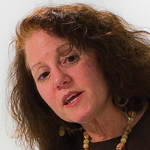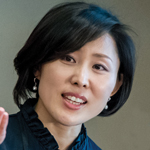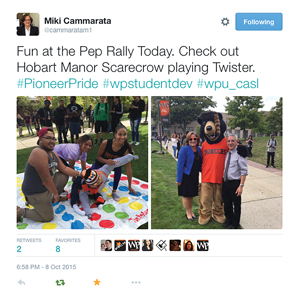Meeting Students Where They Are: William Paterson Harnesses the Power of Social Media
By Samantha DeMuro and Theresa E. Ross ‘80
Christensen, a William Paterson assistant professor of sociology, integrates social media into all of her classes, including courses in social stratification, research methods, and the sociology of social movements. She encourages her students to take out their phones and research current news stories, sociological concepts, and memes (images with text shared widely across social media) during class, providing her the opportunity to give students real-time examples of how social media can be used to engage with the media and comment back on issues of the world.

Professor Wendy Christensen
“I use social media in the classroom because that’s where our students live, it’s their world,” she explains. “I like to remind people, social media is not better or worse communication; it’s just different communication. It has its benefits and drawbacks.”
Christensen provides her students with a list of accounts to follow that have significant social media presences, including the New York Times, and the Washington Post. “I try to encourage them to be good consumers of media, and learn what’s going on in the world, but also how to critique the media.”
The power of social media
Like colleges and universities across the country, William Paterson is focused on providing its students with an engaging, positive experience—in the classroom, on campus, and in the broader community. And social media now plays a significant role in the life of today’s typical student. Students are talking about the University, tweeting, and posting about their experiences to their friends, family, and networks—providing a variety of opportunities to build pride and visibility for the campus, but also to leverage the academic potential of technology that is now a way of life.
It’s no secret that today’s college students are heavy users of social media. According to a 2015 Pew Research Center study, 92 percent of teenagers report going online daily, 56 percent of them go online several times a day, and 24 percent say they go online “almost constantly.” Seventy-one percent of online teens report using more than one social network site, and 52 percent of online adults use more than one social media site.According to eMarketer’s U.S. Digital Media Usage Report, 28.3 million 18 to 24 year olds are using social media regularly.
At the University, social media platforms are active and rapidly gaining momentum. Thousands of students and alumni are engaged on the University’s various official Facebook pages, while Instagram followers have jumped by 181 percent and Twitter followers have increased by 148 percent since fall 2014.
Social media as an educational tool
Technology in the classroom used to mean a smartboard or a laptop computer. Today, with 85 percent of people age 18 to 24 owning a smartphone, a powerful tool is literally in their hands. Tapping the potential of that tool by using social media for hands-on and practical use means that faculty members need to explore new teaching strategies and ways to engage students in the classroom.
”Social media, when used well, helps our students understand that what they are learning in the classroom reflects what is happening outside the classroom,” notes Warren Sandmann, provost and senior vice president for academic affairs (and also a professor of communication). “Social media helps us connect the timeless lessons of our disciplines with the ‘right now’ of what is happening in the world, and helps students see the impact of what they are learning.”
Hilary Wilder, a professor of educational leadership and professional studies, has long integrated various forms of technology into her teaching. This past summer, she specifically created a closed group in Facebook so that students in her graduate course in educational technology could share in a discussion with peer students in the African nations of Namibia and Guyana.

Professor Hilary Wilder
“The students in all three countries worked together via Facebook to develop professional development workshops for other non-technology-using teachers in Guyana and Namibia that would help them use technology in the classrooms with K-12 students,” says Wilder. “Facebook was really the best way to collaborate because it is easily accessible by everyone, even these students in these developing countries who might not own a smartphone.”
Wilder, who also teaches in the University’s new graduate program in higher education administration, says all students in the program are required to have a professional LinkedIn account. “They need to use it both for their own professional development and also to represent their respective institutions,” she says. “It’s an important way to meet current students, prospective students, and all stakeholders.”
In the Department of Environmental Science, an Instagram account, #wpuenvsci, which currently includes more than 500 images, serves as a way to encourage student engagement in the major, which includes hands-on projects in every course. “It’s a great way to capture images of students doing amazing things in the field, or giving a presentation, or graduating,” says Nicole Davi, assistant professor of environmental science.
“It creates a sense of community,” adds Martin Becker, professor of environmental science. “We take our students out on many field trips, and they are instantly posting pictures of the cool fossils they find or the research they are involved in.”

Professor Angie Yoo
In Digital and Social Media, taught by Angie Yoo, assistant professor of communication, students are learning how to use social media as professionals. “Most of the students in my class began using social media as middle school or high school students when it was just for fun,” says Yoo. “But when they know their professor will see their content, the way that they create content will be a little different. It helps them understand that social media is not just their own personal place; it can be used professionally, for businesses and organizations, and for reputation management.”
“Using social media in my class also helps me find new trends and articles,” adds Yoo. “Sometimes I’ll try to explain a concept and one student will share another example or will quickly pull up an article on their phone, and then they’ll say, ‘Oh! I understand!’ It helps me teach better.”
Social media also can play a role in related academic experiences outside the classroom. For example, the William Paterson University Galleries presents numerous exhibitions of contemporary art, as well as educational programs, all designed to support courses in the Department of Art as well as foster a community dialog about the visual arts and culture. This fall, the Galleries have collaborated with exhibiting artist Raymond Saa by posting photos to Instagram to encourage students to visit the gallery and learn about various art forms.
“We’ve posted photos with hashtags like #collage, #colortheory, and #painting—all related to Raymond Saa’s work—which allows us to direct students to collections of images focused on various art mediums and give them more information about what they can see in person,” says Kristen Evangelista, gallery director.
Giving students an increased sense of belonging
While faculty are just beginning to integrate social media into their courses, social media is already a critical tool for driving social engagement on campus.
“Social media is an extremely useful tool to stay in touch with all of the things that are happening on campus,” says Sandmann, who maintains a blog and actively uses Twitter (his handle is @ProvostWPU). “One of the best benefits of Twitter is that it gives me an opportunity to offer kudos, a congratulations, or a retweet,” he says. “It makes people aware that I’m paying attention.”
For Miki Cammarata, vice president for student development, being active on social media (@cammaratam1) is another opportunity to be accessible. “What I love most is the personal interaction with students,” she says. “I go to events and programs, but social media is another way for students to get to know me. For administrators who use these platforms, it gives us a chance to say we’re human, that we have some of the same ideas and thoughts, and that we’re interested.” Being active on social media, she continues, is just another layer of support, accessibility, and interaction. “It’s really for students and that’s why it’s important,” she adds.

Miki Cammarata, vice president for student development,
takes to Twitter to boost campus pride before Homecoming 2015
While social media does not replace face-to-face interaction, it has the ability to enhance interactions. What begins with a post or a tweet sometimes ends in a face-to-face meeting or attendance at a campus event. “In our field in particular, student development, we have to go where the students are, but that doesn’t mean that we have to abandon everything we’ve done before,” says Cammarata.
Cammarata oversees the Office of Campus Activities, Service, and Leadership, which recently encouraged student leaders to participate in social media leadership training. At the workshop, student ambassadors learned how to use social media for engagement and pride building. “As a result, athletics has seen an uptick in support and attendance of games,” says Cammarata. “All these efforts to engage with our students have proven effective.”
Jaclyn Antonacci ‘14, a graduate assistant in marketing and public relations who is pursuing a master’s degree in professional communication, is researching how student interactions with their university on social media affects their sense of belonging. Although her research is still in the preliminary stage, Antonacci believes the study will show that social media is effective at helping students feel that they have value. “Even when a university is speaking to many students via social media, it’s reaching them in a way that is personal and less rigid. It gives students individual attention, it values their voice, and it allows them to share and get excited about our University community,” she says.
Providing answers to questions online is one way an institution can show its students that it is listening and cares, Antonacci continues. “Even if students don’t get an exact answer immediately, or a University staffer must refer the student to someone else, the online response provides a human touch. Students may be more likely to reach out again if there is an issue, and it allows for a university to be proactive,” she says. Students often retweet a university response, which goes out to their personal networks and feeds, and shows other students and people that the university is responsive, caring, and informative, and that students matter.

Jaclyn Antonacci '14
“William Paterson University does a great job of making students feel their voice is heard,” says Antonacci. “It is about celebrating together, but it’s also great for customer service, problem solving, and resource and information sharing. It relates to the student experience in a way that really can’t be done in traditional media.”
Meeting students now and after graduation
Social media can also be an important tool in recruiting prospective students. When a high school student tweets, “William Paterson is my dream school,” and the University tweets back: “Great! We look forward to having you as a student on campus. Let us know if you have any questions,” that positive interaction could be viewed as an unsolicited online endorsement.
By creating a hashtag, #WPAccepted, prospective students this fall were able to meet other students online, and share their excitement for attending William Paterson across Twitter and Instagram.
When students graduate, social media is the main means through which they can continue to stay in touch with their classmates and their alma mater.
“Social media has been so valuable for us,” says Janis Schwartz, executive director of alumni relations. “Alumni have been able to find each other online years after graduating. They are connecting with each other on LinkedIn and sharing what they have been doing since they’ve graduated.”
It’s also been an effective way to keep alumni up to date with the latest University news and events, whether it’s Homecoming, a job fair on campus, an alumni music performance, or even a reminder to tune into the SyFy channel to catch Ian Ziering ’88 in the pop culture movie phenomenon Sharknado.
“For the current and incoming generation of college students, we feel, and have always felt, comfortable sharing our experiences online,” says Antonacci. “It only makes sense for our University to meet us where we are.”
To see the full range of William Paterson University departments on social media, visit our Social Media Directory: http://wpunj.edu/socialmedia
Connect with William Paterson alumni on social media:
facebook.com/wpunj
twitter.com/wpunj_alumni
instagram.com/wpunj_alumni




